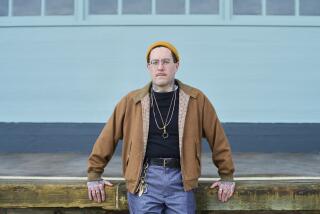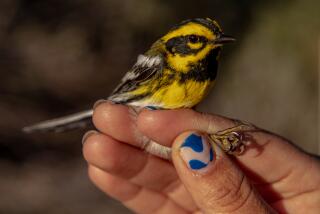Artistic afterlife
- Share via
It was easy to find Tony Finazzo’s house. His directions led into a well-kept tract in the foothills of San Bernardino. You could see his place from a block away. Tony’s house was the one with a 12-foot blue marlin in the driveway, awaiting pickup by a customer.
If you want to get on Tony’s good side, you will acknowledge this torpedo-sized fish as a work of art.
The same with the pintail ducks, caribou, deer, elk and the rattlesnakes, boar, parrots, sheep and chickens, brown trout and all the rest of the no-longer-living creatures that come out of his workshop -- artistic realism of the most realistic sort.
But it’s OK with Tony if you begin by calling him a taxidermist.
“There’s been a big push to have taxidermy seen as an art,” Finazzo says. “So instead of the snarling, growling bear, you see animals presented a lot more subtly, more relaxed in their natural settings.”
As a consequence, the taxidermist is apt to take the conversation right past the measuring of Boone and Crockett potential of a rack of antlers. If given the chance, he will instead veer to techniques for painting the feet of birds, or the challenge of storytelling in the confined parameters of a mounting case, or the creative use of empty space when composing a scene.
Not so long ago, taxidermy was -- put aside the pun -- a dying enterprise. But today Finazzo sees renewed interest in this old-fashioned form of virtual reality. The California Assn. of Taxidermists has 300 members, with Finazzo in his fourth year as president. A company that supplies the trade has 2,000 customers in the state, a number that includes hobbyists. Taxidermy schools can be found around the nation, and Finazzo says plenty of young people enroll in taxidermy schools along with retirees and workers retraining for second careers. At least four periodicals serve the trade, and 40 taxidermy conventions and competitions are scheduled around the nation this year, including the annual California meeting March 18-20 in Redding.
True, hunting is in decline in the United States and that worries taxidermists. But an artist with a reputation like Finazzo remains in demand. He has “several freezers full” of animals ready for mounting -- a backlog that means customers wait from three to six months from drop-off to pickup.
Besides, game trophies are no longer the sole concern of the taxidermy trade.
Off the main hallway of his home, Finazzo’s cluttered “bird room” is notable not only for ducks and grouse, but also for barnyard birds and half a dozen assorted parrots -- the latter captive animals that died of natural causes. One of Finazzo’s five first-place awards in national competitions was for a bantam rooster mounted on the handle of a weather-worn farm shovel.
Lately, some self-styled “rogues” have stirred up the business and attracted news attention with unconventional mounts of and stylized creations of fantasy animals.
But Finazzo sticks with the traditional aspiration of the taxidermist: “To make the animal as alive as possible,” a way of putting things that is sure to earn snipes from some circles.
If he cared to respond, he could point out that his fish mounts are 100% reproductions -- fiberglass and paint at $14 an inch with nothing from an animal itself except the inspiration of a photograph. His other creations, though, are the real thing, including mammals, reptiles and Finazzo’s passion for 43 years, birds.
“There’s a mystery to them that intrigues me,” he says. “And they’re not very easy to make look good.”
Birds are not distinguished by antlers or size, so customers preserve them to hang on to the memory of a particularly great hunt, or a specific day hunting, or, in Finazzo’s words, “so hunters can remind themselves of what they love to do.”
Finazzo was 15 when taxidermy caught his interest. He shot a wood duck, a creature that was all the more fascinating and beautiful the closer the teen-ager looked. His father told him the family couldn’t afford to have it mounted.
“He said, ‘I’ll take you to the library and you can learn to do it yourself,’ ” Finazzo recalls.
Today, a Finazzo duck mount starts at about $250. Rates by other taxidermists vary from $65 to $400.
A burly man with an easy manner, Finazzo pursued taxidermy as a paying hobby throughout a 34-year career as a high school biology teacher and athletic coach in San Bernardino. Now retired, it is a full-time occupation.
Beyond doing his own mounts, he has become one of the country’s four primary suppliers of cast polyurethane bird heads for other taxidermists. His collection includes 400 different species and sizes, with a goal “to eventually have everything that can be mounted.”
As you might expect, a taxidermist in his fifth decade of work accumulates a good many favorites in his personal collection.
His 10-by-12 foot bird room contains about 75 mounts, plus a stuffed rattlesnake -- “stuffed” being a word that is seldom used in the trade anymore -- and a teddy bear. The walls in his den, or trophy room, display mammals, fish and a spillover of birds -- a menagerie big enough to keep someone with a feather duster busy each day. Wall space not occupied by wildlife is filled with a lifetime of awards.
“If you ask my wife, there’s too many,” he says. But he quickly adds, as if this conversation has come around before, “I don’t want to get rid of any.”
In fact, Finazzo is still on the hunt for more specimens -- and willing to pay for some.
What would he most covet?
A macaw. “I think they are so beautiful.”
One creature the taxidermist would rather not undertake, though, is a deceased pet. He has been asked by would-be customers, but has turned most of them down. A deer or a duck can be replicated to satisfy any hunter or naturalist. But a pet owner has a relationship of many years with a cat or dog. Just a fraction of an inch variance in proportions or facial expression can leave a customer disappointed.
“I can do a yellow lab, and it will look like a yellow lab,” he says.
“But,” he continues, pointing to Duke, his field dog lying on the floor with a disinterested look on its face, “I can’t do that yellow lab.”
More to Read
Sign up for The Wild
We’ll help you find the best places to hike, bike and run, as well as the perfect silent spots for meditation and yoga.
You may occasionally receive promotional content from the Los Angeles Times.






